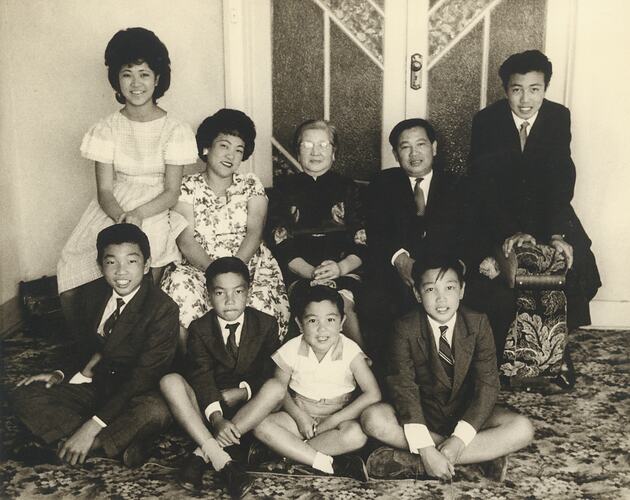Summary
Photograph of the Gung family at Mary and Samuel Gung's family home at 24 Madura Street Ascot Vale, Melbourne, circa 1965. The family are wearing formal clothes and would have been on their way to or from church. From left to right: [back row] Phyllis Louey Gung [eldest daughter), Mary Louey Gung (mother), grandmother Louey Gung (who lived nearby), Samuel Louey Gung (father), Jeffrey Louey Gung (second eldest son]; [front row] David Louey Gung [third eldest son], Martin Louey Gung [fifth eldest son], Colin Loey Gung [youngest son], Leslie Louey Gung [fourth eldest son]. The photograph was taken by relative Phillip Louey Gung.
Samuel Louey Gung, the son of Sydney Louey Gung, was born in Carlton in 1920 and died in Melbourne in 1993. He was educated in China and married Mary Mak in 1941. They migrated with two children in 1947 and had a further five children in Melbourne. Samuel worked with his father in the Geraldton Fruit Company.The Gung family collection documents their experiences of immigrating and living in Australia from the 1920s to the 1960s and the gradual easing of the White Australia policy.
Description of Content
Nine people grouped for a portait in a carpeted living room with a pair of glass doors in the background.
Physical Description
Black and white photograph.
Significance
The Gung family collection provides an invaluable representation of Chinese migration and settlement experiences in the Museum's migration collections. The family narrrative spans two generations, enabling the exploration of key themes such as the establishment and gradual dillution of the White Australia policy, Chinese businesses and the labour market, and family life. Many of the documents in the collection reflect the gradual easing of the restrictions on Asian immigration which occurred in the 1950s and 1960s, policy shifts which contributed to the Racial Discrimination Act of 1975. The objects compliment the photographs and documents and tell the story of a family's desire to continue their cultural practices and remember their cultural heritage while living in Australia from the 1920s to the 1960s.
More Information
-
Collecting Areas
Migration & Cultural Diversity, Home & Community, Images & Image Making
-
Acquisition Information
Donation from Jeff Gung, 11 Feb 2013
-
Person Depicted
Jeff Gung, Ascot Vale, Greater Melbourne, Victoria, Australia, circa 1965
-
Individuals Identified
Samuel Louey Gung; Mary Louey Gung; Jeffrey Gung
-
Format
Print, 8" x 10", Black & White
-
Classification
Migration, Settlement - cultural & social life, Family portraits
-
Category
-
Discipline
-
Type of item
-
Image Dimensions - Photograph
250 mm (Width), 200 mm (Height)
-
Keywords

